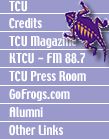|
Wednesday,
September 12, 2001
Media
organizations plan ahead to provide accurate crisis coverage
By Piper Huddleston
Staff Reporter
Gordon
Keith normally serves as comic relief during the his morning
sports show on 1310 AM The Ticket, and all-sports radio station.
Tuesday he was reporting the news.
When
disaster strikes, the public has come to expect around-the-clock
coverage. To coordinate this coverage, it takes quick planning
and natural curiosity, said Paul Harral, vice president and
editorial director for the Fort Worth Star-Telegram.
“Generally
it’s not rocket science,” Harral said. “The
most important thing is to figure out what you would want
to know if you were a reader and then answer those questions.”
The
Star-Telegram has a special crisis team that is experienced
in handling emergency situations, Harral said. He said the
team is prepared to fly to New York City as soon as airports
reopen.
When
disasters break, Harral said editors generally get together
to brainstorm general story topics. From there, reporters
are broken up into teams to cover these topics.
Newspapers
across the country, including the Fort Worth Star-Telegram
and The Dallas Morning News put out special editions.
Information
during a catastrophe comes from wire services, people calling
in information, reporters calling contacts and live coverage,
Harral said. The challenge of a reporter is to sort through
that information for what is reliable.
The
Star-Telegram has a fact board, where they list everything
they know to be true and all reporters verify their information
with the board, Harral said.
“You
get real cautious,” Harral said. “You try not to
overstep anything.”
John
Miller, adjunct journalism professor and former news director
at WFAA Channel 8, said reporters frequently make mistakes
when covering an event with speculation flying around.
When
the Oklahoma City bombing occurred, reporters assumed Middle
East terrorists were responsible, although it was actually
Timothy McVeigh. Credibility is lost when reporters speculate,
Miller said.
Miller
said stakes can be big when covering events like those on
Tuesday.
“This
is the first time in history that people have actually witnessed
an airplane crash into the second largest building in the
United States,” he said. “This is the biggest event
to be on TV since the assassination of (President John F.
Kennedy), and it may be bigger.”
Sports
editor Brandon Ortiz contributed to this report
Piper Huddleston
c.p.huddleston@student.tcu.edu
|
